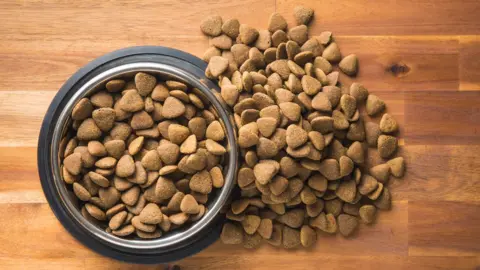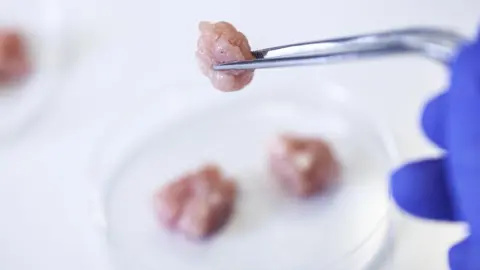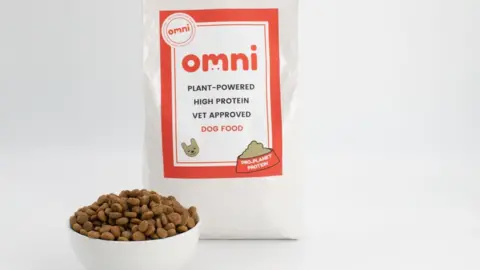 Nicola Wordsworth
Nicola WordsworthNicola Wordsworth says her pet Tibetan Terrier Bertie shares her dietary regime.
“I’m a a flexitarian – on-off vegan and vegetarian. I don’t do dairy and I rarely do meat,” says the 54-year-old from Kent.
“Bertie is on-off vegan and vegetarian too. And when he has meat in his food, I ensure it is sustainable, low mileage and good quality, same as for me.”
The global pet food sector emits more greenhouse gases than countries including Mozambique and the Philippines, according to one report.
The same paper also calculated that every year an area double the size of the UK is used to produce dry pet food for cats and dogs, to say nothing of wet foods.
 Getty Images
Getty ImagesSo is it time to take conventional meat off the menu for our pets, and instead switch to more sustainable alternatives, such as vegan foods, insects, and even lab-grown meat?
The latter is also known as cultivated meat, and London-based Good Dog Food is hoping to bring it to market in the next few years.
A joint venture between two biotech firms, Agronomics and Roslin Technologies, its research team is already growing lab-made chicken.
The manufacturing process for lab-grown meat begins with stem cells, typically taken from an embryo, but also sourced from adult animals, that are then grown in a laboratory. In a method similar to what happens inside an animal’s body they are fed nutrients such as amino acids, glucose and vitamins.
The technique produces meat without the livestock, without the need to raise and slaughter animals. And the Good Dog Food team says there is no need to source additional stem cells because the stock is “infinitely renewing”.
 Getty Images
Getty Images“Cultivated meat provides the option to feed cats and dogs animal material-based diets without the ethical and environmental implications associated with feeding them traditional meat,” says Prof Jacqui Matthews, former chief scientific officer for Roslin Technologies.
“[By contrast], vegan pet diets can have synthetic supplements added. [And] there is limited evidence to indicate that this is a safe, long-term option.”
Owen Ensor, chief executive of Good Dog Food, says lab-grown meat uses significantly less land, water, and electricity, and reduces agriculture-related pollution, deforestation and biodiversity loss. It is also expected that production will not require the use of any antibiotics.
“My partner and I would love to get a little fur ball of our own,” he adds. “But being vegan we’ve struggled to align owning a pet with the environmental and moral cost of owning one. Hopefully Good Dog Food might just solve that.”
 Jacqui Matthews
Jacqui MatthewsDog nutritionist Alyssa Ralph says it is not unusual for an owner to apply his or her own food choices to their pet.
“Pet food diets often follow human food trends very closely,” says dog nutritionist, Alyssa Ralph. “One major example of this was seen when gluten-free diets became very trendy for people, and shortly after the grain-free pet industry suddenly exploded.
“More recently, we have seen this trend with vegan diets.”
One plant-based dog food brand, London-based Omni, says it has seen a more than six-fold growth in sales since September 2021 and sold more than 90,000 vegan dog meals to date.
 Omni
OmniIts co-founder, Guy Sandelowsky, is also a small-animal veterinarian. He says trying to feed animals with the meat their wild ancestors would have eaten is not actually necessary.
“We know they need protein but it’s possible to provide dogs with all the protein they need from plant-based foods.”
 Guy Sandelowsky
Guy SandelowskyWhether or not we should feed our dogs what their predecessors would have eaten in the wild is a controversial topic.
“The predominant argument is that we should be feeding our pet dogs an ancestral diet, in line with what modern-day grey wolves consume,” says Ms Ralph.
“However, whilst our dogs and grey wolves share a common ancestor, we started domesticating dogs between 15,000 and 40,000 years ago, with some ‘proto-dogs’ [the first dogs descended from wolves] potentially appearing up to 100,000 years ago.”


New Tech Economy is a series exploring how technological innovation is set to shape the new emerging economic landscape.

Nicole Paley, the Pet Food Manufacturers’ Association’s deputy chief executive, points out that the pet food industry is renowned for reducing waste from the human food chain. For example, by using much of the offal.
“However,” adds Ms Paley, “as the squeeze on resources and food availability continues, we are committed to looking for further solutions.”
Ms Paley describes recent innovations in protein sources, including from algae, aquatic plant duckweed, the black soldier fly, and lab-grown meat.
However, back in Kent, Nicola Wordsworth says she would feel a little “squeamish” eating cultivated meat herself, or giving it to Bertie. Instead she says that both of them will stick to being mostly vegan. “He enjoys it. He’s happy and healthy.”




